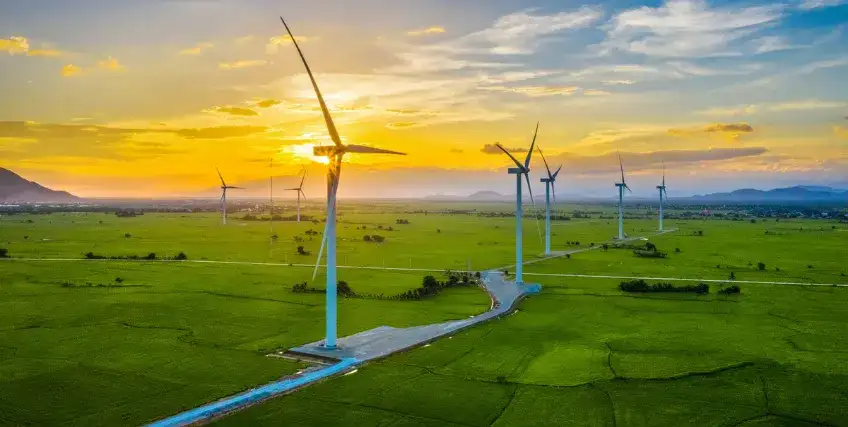Clean Energy Financing: Reduce Carbon Footprints & Fund Sustainability
September 24, 2025 | Last Updated on: September 24, 2025

Clean energy financing is the financial engine driving the transition away from fossil fuels and reducing greenhouse gas emissions. It enables the deployment of sustainable energy resources worldwide.
This article reviews clean energy financing options, clean energy financing lenders, exploring its impact on decarbonization, from supporting renewable energy projects to fostering industrial sustainability, and highlighting its growing significance in the modern energy landscape.
What is Clean Energy Financing?
Clean energy financing, also known as green energy funding or renewable energy funding, refers to the allocation of financial resources to facilitate the development and implementation of clean energy technologies and initiatives.
Key funding avenues include government incentives, such as grants, subsidies, and tax credits, which mitigate the financial burdens associated with clean energy investments.
The U.S. Department of Energy (DOE) and Loan Programs Office (LPO) play a role in administering many of these loan programs and clean energy financing programs. Private investments, encompassing venture capital and private equity, play a role in supporting clean tech startups and established renewable energy projects.
Green bonds, debt instruments specifically designated for environmentally friendly ventures, are another source of funding. Additionally, a range of other sources, including philanthropic funds, international development banks, and specialized financial institutions, contribute to the overall clean energy funding ecosystem. State energy financing institutions (SEFI) and local governments also provide financial support through various loan programs and initiatives.
The U.S. Department of Energy provides a comprehensive overview of state-level incentives and laws related to renewable energy and energy efficiency on their website.
How Green Energy Financing Reduces Carbon Emissions
Green energy financing reduces carbon emissions by channeling financial resources to initiatives that directly address climate change. For example, the development of renewable energy projects such as solar, wind, hydro, and geothermal power plants, which replace traditional fossil fuel-based electricity generation.
It drives energy efficiency initiatives, including building retrofits, smart grid implementations, and the adoption of energy-efficient technologies, leading to reductions in energy consumption. Renewable energy finance also promotes sustainable transportation solutions, such as electric vehicles and public transit. It enables businesses both large and small to pursue decarbonization efforts enabling businesses to adopt sustainable practices and reduce their carbon footprint.
How Clean Energy Funding Works
Clean energy funding works in a variety of ways. For example, Government incentives and tax credits, such as those included in the Inflation Reduction Act, play a role in making clean energy investments more financially viable.
There are green banks that attract environmentally conscious investors, providing essential capital for large-scale renewable energy projects. Power Purchase Agreements (PPAs) offer long-term financial stability for project developers by securing fixed-price electricity sales. Public-private partnerships foster collaboration between governments and private sector entities, enabling joint financing and implementation of clean energy initiatives.
The DOE and LPO offer a range of loan guarantees and credit enhancements to mitigate risk and attract private investment in energy infrastructure projects. Loan funds are often structured with favorable interest rates to encourage investment in clean energy technologies.
In addition to these established avenues, online lenders are expanding access to clean energy funding for small and medium-sized businesses. They offer streamlined application processes and flexible financing options, addressing the specific needs of businesses seeking to adopt sustainable practices. By leveraging technology and data-driven assessments, internet lenders are playing an increasingly important role in democratizing access to clean energy capital.
The DOE's Title 17 Clean Energy Financing Program
The DOE's Title 17 Clean Energy Financing Program is an initiative aimed at accelerating the deployment of clean energy and decarbonization technologies in the United States. The program offers loan guarantees for a wide range of projects, including those involving renewable energy systems, advanced fossil energy technology, hydrogen fuel cell technology, advanced nuclear energy, carbon capture and sequestration technologies, and more.
The Title 17 program has been instrumental in supporting innovative and high-impact clean energy projects, such as the first utility-scale wind and solar projects in the United States, the next generation of advanced nuclear reactors, and the nation's first clean hydrogen energy and storage project.
The program's loan guarantees help to reduce risk for private investors and make clean energy projects more financially attractive. This, in turn, encourages greater investment in clean energy technologies and accelerates the transition to a cleaner, more sustainable energy future.
How Can You Utilize Green Loans?
Green loans are important in helping businesses achieve their sustainability goals and can contribute to a greener future. These loans allow businesses to invest in a wide range of eco-friendly initiatives, reduce their environmental impact, and often improve their bottom line through increased efficiency and reduced operating costs. Here are some key applications:
- Installing Solar Panels: Reduce electricity costs and reliance on fossil fuels.
- Upgrading to Energy-Efficient Equipment: Lower energy consumption and operational costs.
- Retrofitting Buildings for Energy Savings: Improve insulation, upgrade windows, and implement smart energy management systems.
- Integrating EV Charging Stations: Attract environmentally conscious customers and employees.
- Implementing LED Lighting Solutions: Reduce energy consumption and maintenance costs.
- Enhancing Water Conservation Systems: Conserve water and reduce water bills.
- Adopting Smart Energy Solutions: Optimize energy usage and reduce waste.
- Building or Renovating Green Facilities: Create sustainable and energy-efficient workspaces.
- Regulatory Compliance Meeting: Ensure compliance with environmental regulations.
- Reducing Carbon Footprint: Minimize environmental impact and contribute to a greener future.
While these represent key applications, businesses should explore the full potential of green funding to drive their sustainability goals and realize both environmental and economic benefits.
Types of Green Energy Loans
Green energy loans provide businesses and individuals with the financial support needed to invest in renewable energy solutions and energy-efficient upgrades. These loans come in various forms, each tailored to different needs and preferences:
- Term Loans: Ideal for large-scale projects like solar panel installations or energy-efficient HVAC systems, term loans offer a lump sum with fixed interest rates and structured repayment terms.
- Equipment Financing: Enables businesses and homeowners to purchase or lease renewable energy equipment, such as solar panels or battery storage systems, spreading the cost over time.
- Commercial Real Estate Loans: Support the purchase, construction, or retrofitting of properties to meet energy efficiency and sustainability standards, often with incentives like lower interest rates for green-certified buildings.
- SBA Loans: Backed by the Small Business Administration, these loans offer favorable terms and potential rebates for businesses adopting renewable energy.
- Revenue-Based Financing: Allows businesses to repay loans based on their revenue, providing flexibility for those with fluctuating income.
Choosing the right green energy loan is important for maximizing both financial and environmental impact.
Final Thoughts
Clean energy financing is a financial instrument driving the transition towards a sustainable future. By directing investments into clean energy technologies and projects, we can reduce carbon emissions and mitigate the adverse effects of climate change. Continued expansion of clean energy financing by industries, governments, and individuals is imperative.
FAQs about Clean Energy Financing
What is clean energy financing?
Clean energy financing encompasses the various ways to secure funding for projects that support clean and renewable energy sources, improve energy efficiency, and promote sustainable practices. This can involve government grants and loans, tax credits, private investments, green bonds, and public-private partnerships.
What types of projects can be financed through clean energy programs?
Clean energy programs can fund a wide range of projects, including renewable energy generation (solar, wind, hydro, etc.), energy efficiency improvements (building retrofits, efficient appliances), sustainable transportation (EV charging, public transit), energy storage (batteries, pumped hydro), and carbon capture and storage technologies.
What is the 30% clean energy credit?
The 30% clean energy credit, also known as the Investment Tax Credit (ITC), is a federal tax credit that allows homeowners and businesses to deduct 30% of the cost of installing eligible clean energy systems, such as solar panels, wind turbines, and geothermal heat pumps, from their federal taxes.
How do you finance renewable energy?
Renewable energy projects can be financed through a combination of government incentives (grants, loans, tax credits), private investments (equity, debt), green bonds, Power Purchase Agreements (PPAs), and public-private partnerships.
Are there tax incentives available for clean energy projects?
There are various tax incentives available at the federal, state, and local levels, including the ITC, Production Tax Credit (PTC), property tax exemptions, sales tax exemptions, and accelerated depreciation, all aimed at making clean energy projects more financially attractive. However, if unsure should consult a tax professional for more clarity.
Frequent searches leading to this page
Related Articles
Green Energy Funding in Emerging Markets: Opportunities, Risks & Scale-Up Paths
October 24, 2025
Challenges in Green Funds Loans Implementation: Barriers and Solutions
October 14, 2025
Building Green, Financing Smart: A Guide to Green Bonds and Loans for Sustainable Transformation
September 24, 2025




